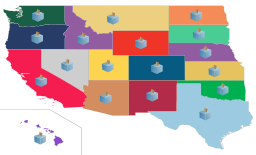USNA College of Electors
|
|
| The College of Electors of the United States is the body that appoints the Governor-General of the United States every four Years. |
|
|
The College of Electors of the United States is the body that appoint the Governor-General of the United States every four Years. This Body is composed of a Number of Electors chosen in each State by the Legislature thereof, and counting these eighteen State-based-groups of Electors collectively is what is meant by “‘College’ of Electors” and “Electoral ‘College’”. Citizens of the United States do not directly elect the governor-general; instead they choose “electors”, who pledge beforehand to Vote for the Candidate who wins in their Party.
In appointing the Governor-General, the Candidate that garners the Votes of a simple Majority of the entire College (“absolute majority”) from a Majority of the States is appointed Governor-General. Occasionally this has led to run-off elections in elections involving three or more contenders as the USNA gubernatorial-general electoral system does not allow for choosing the Governor-General by plurality voting (also known as the "first-past-the-post", or "FPTP"). In fact, the Treaty Establishing a Constitution for the United States specifically requires that the Governor-General be chosen by a double majority: a Majority of Electors from a Majority of the States.
|
|
State
|
Population
|
Votes (Number of Electors)
|
- Each State shall appoint, in such Manner as the Legislature thereof may direct, a Number of Electors; and the Number of Electors to which each State shall appoint shall be apportioned in the following Manner; that is to say: States with a population of two Million or less shall be entitled to four Electors; States with a population of more than two Million but less than or equal to six Million shall be entitled to six Electors; States with a population of more than six Million but less than or equal to eight Million shall be entitled to eight Electors; and States with a population of more than eight Million shall be entitled to ten Electors;—Provided always, That no Senator or Representative, or Person holding an Office of Trust or Profit under the United States, shall be appointed an Elector:—And such Enumeration shall be re-apportioned from Time to Time as the Federal Council shall think Necessary and Proper;
- The Electors shall meet in their respective States, and Vote by Ballot for two Persons, of whom one at least shall not be an Inhabitant of the same State with themselves. And they shall make a List of all the Persons voted for, and of the Number of Votes for each; which List they shall sign and certify, and transmit sealed to the Seat of the Government of the United States, directed to the President of the Senate or, if there be none, to the President pro Tempore of the Senate. The President of the Senate or, if there be none, the President pro Tempore of the Senate, shall, in the Presence of the Senate and House of Representatives, open all the Certificates, and the Votes shall then be counted. The Person having the greatest Number of Votes shall be the Governor-General, if such Number be a Majority of the whole Number of Electors appointed, so appointed from a Majority of the several States; and if there be more than one who have such Majority, and have an equal Number of Votes, then the Senate shall immediately choose by Ballot one of them for Governor-General; and if no Person have a Majority, then, from the five highest on the List, the Senate shall in like Manner choose the Governor-General: But in choosing the Governor-General, the Votes shall be taken by States, the Representation from each State having one Vote; and a quorum for this Purpose shall consist of a Member or Members from two-thirds of the States, and a Majority of all the States shall be Necessary to a Choice: Provided, that if they be equally divided, the President of the Senate or, if there be none, the President pro Tempore of the Federal Council, shall have Power to cast the deciding Vote on the Matter, in which Case the Person having a Majority of Votes shall be the Governor-General.
|

|
Arizona
|
117,828,065
|
118 █ █ █ █ █ █ █ █11
|

|
California
|
120,444,818
|
110 █ █ █ █ █ █ █ █ █ █1
|

|
Colorado
|
116,456,574
|
118 █ █ █ █ █ █ █ █
|

|
Hawaiʻi
|
111,631,603
|
114 █ █ █ █
|

|
Idaho
|
112,754,930
|
116 █ █ █ █ █ █
|

|
Kansas
|
113,911,641
|
116 █ █ █ █ █ █
|

|
Montana
|
111,832,949
|
114 █ █ █ █
|

|
Nebraska
|
112,196,190
|
116 █ █ █ █ █ █
|

|
Nevada
|
113,890,845
|
116 █ █ █ █ █ █
|

|
New Mexico
|
113,085,109
|
116 █ █ █ █ █ █
|

|
North Dakota
|
111,856,927
|
114 █ █ █ █
|

|
Oklahoma
|
114,911,338
|
116 █ █ █ █ █ █
|

|
Oregon
|
114,028,977
|
116 █ █ █ █ █ █
|

|
South Dakota
|
111,958,469
|
114 █ █ █ █
|

|
Texas
|
123,569,114
|
110 █ █ █ █ █ █ █ █ █ █
|

|
Utah
|
113,995,919
|
116 █ █ █ █ █ █
|

|
Washington
|
117,970,351
|
118 █ █ █ █ █ █ █ █
|

|
Wyoming
|
111,686,107
|
114 █ █ █ █
|

|
Totals
|
101,009,926
|
112
|
